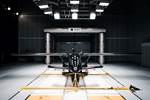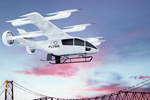Eve Air Mobility completes eVTOL wind tunnel testing
A scale model of the lift + cruise eVTOL aircraft was tested to further refine the understanding of how the components will perform in future flight.
Eve Air Mobility (São José dos Campos, Brazil) recently completed wind tunnel testing of its electric vertical takeoff and landing (eVTOL) vehicle. The testing, which was conducted at a wind tunnel near Lucerne, Switzerland, used a scale model of Eve’s eVTOL which is projected to enter service in 2026.
Wind tunnel testing is an important engineering tool used in the development of an aircraft. The testing enables engineers to monitor the flow of air over and around the vehicle and each of its individual parts. It is also used to measure the aerodynamic forces and moments acting on the vehicle, allowing the team to evaluate the vehicle’s lift, efficiency, flying qualities and performance.
The main objective of the test was to investigate and validate how components including fuselage, rotors, wing, tail and other surfaces would perform in flight. It also provided the company with an understanding of the aerodynamic behavior of complex geometries and provides a higher level of validation of design characteristics. The tests are part of an effort to acquire experimental data to validate production solutions, development tools and models which also includes other test articles such as fixed and moving rigs, flying vehicles and other wind tunnel tests.
“The completion of wind tunnel testing is an important engineering milestone as we continue the development of our eVTOL,” Luiz Valentini, chief technology officer at Eve Air Mobility, says. “The information we obtained during this phase of development has helped us further refine the technical solutions of our eVTOL before committing to production tooling and conforming prototypes. Our goal is to design, produce and certify an aerodynamic and efficient eVTOL that will be used for a variety of urban air mobility [UAM] missions.”
Eve’s engineering team will use the data gathered through wind tunnel testing to continue to develop the eVTOL’s control laws leading to optimal performance and passenger comfort.
Eve’s eVTOL is 100% electric and has a range of 60 miles (100 kilometers) allowing it to complete a variety of UAM missions. Its human-centered design is said to ensure the safety, accessibility and comfort of passengers, the pilot and the community by minimizing noise. The aircraft features a lift plus cruise configuration with dedicated rotors for vertical flight and fixed wings to fly on cruise, with no components required to change position during flight. It will be piloted at launch, but ready for autonomous operations in the future.
Related Content
-
Braided thermoplastic composite H2 tanks with co-consolidated molded boss areas to fit EV battery space
BRYSON project demonstrates possible designs, automated manufacturing and low permeability concepts, including EVOH liner and novel PPA matrix.
-
Midnight production aircraft completes full transition flight
This is Archer’s second full-scale eVTOL aircraft to achieve this milestone, critical to being able to carry commercially viable passenger payloads.
-
ECOHYDRO project to enable recyclable composites for hydrogen storage
With the involvement of two schools from the Institut Mines-Télécom, the 4-year project aims to improve the intrinsic properties of a composite material based on Elium via four concrete demonstrators.
















